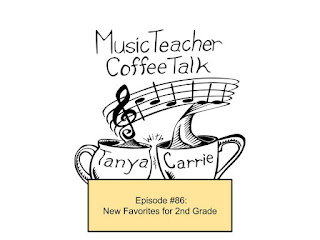Episode #145: Transitions (Recipes for Success Part III)

Check out this episode on YouTube!
Main Theme: Primary Lesson Segments (Recipes for Success, Part III)
We are continuing our Recipes for Success series and today's episode is all about transitions. Think of daily lesson plans as a layer cake and the lesson segments are like the foundational layers of the cake. The transitions are like the layers between the cake that bring more flavor and texture.
What are transitions?
Transitions are the ways in which your seamlessly flow from one lesson segment to the next. Having smooth transitions not only helps your lessons flow and feel magical, they also help with classroom management because students don't get as many opportunities to get bored or distracted. There are many types of transitions, and we are going to focus on our favorites as labeled and described in Rita Klingers's book Lesson Planning in a Kodály Setting: A Guide for Music Teachers.
Transition types and examples:
Verbal Transitions: using words
- Thematic: Using a story, theme, or character to move from one segment to another. Be careful because theses can get out of control!
- Example: After reading a book like The Very Lonely Firefly that has a picture of stars at the end and the move into the song Starlight Starbright.
- Directive: Asking questions or directing students to a knew physical space.
- Example: Asking questions about what they hear like "How many re's do you hear in this phrase?" in two different songs.
- Example: Playing an elimination game and when students get out they transition to an instrument to play the beat or bourdon. Then continue using those instruments for your next activity.
- Example: Sing directions of what you want the students to do to the tune of the song you've just done or the song that comes next.
Non-Verbal Transitions
- Physical cues: Use cues to show students what you want them to do.
- Examples: Have cues for standing, sitting, making circles, lining up, etc.
Tonal or Melodic Transitions
- Motif transition
- Example: Use the last phrase of song 1 is the same as the first phrase of song 2.
- Example: Use an ostinato derived from a song and ask students to continue the singing ostinato while the teacher starts singing the next song.
- Altered motif transition
- Example: Change a motif one night at the time so that it becomes the first motif or phrase for another song.
- Tone set or key connections
- Example: Sing a series of songs in the same key (do is the same).
- Example: Use the final pitch of song 1 to become the first pitch of song 2 which then becomes a modulation to a new key.
- Example: Intentionally raise the pitch of a song with multiple verses or game repetitions to move up by 1/2 step to the key of the next song you'll be doing in the lesson.
Rhythmic Transitions
- Rhythmic connection
- Example: Use the same rhythmic element, pattern, or phrase to connect one song the next by echoing rhythms. Consider changing tempo if needed.
- Altered rhythm connection
- Example: Change the rhythm of song 1 one beat at a time to become song 2. Look for two songs that are similar enough where you only need to make no more than 5 changes.
- Example: Use dictation (either writing notation or using manipulatives) or games like Poison Pattern to read or write many patterns with specific elements and then the last pattern the students read or write is the first pattern of the next song in the lesson.
Resources we mention in this episode:
- Lesson Planning in a Kodály Setting: A Guide for Music Teachers by Rita Klinger
- First We Sing! Activity Cards for Preparation and Practice by Susan Brumfield
Know Better, Do Better
As we move into November and Native American heritage month, Tanya highlighted the work of Music Educator Michelle McCauley. Michelle is a member of the Pyramid Lake Paiute Tribe and shares many resources and perspectives with music educators regarding the use of Indigenous music in the classroom and ways to avoid cultural appropriation. She has an excellent YouTube channel, is a contributor to Decolonizing the Music Room, and recently published a picture book and song with F-flat books called Kammu Kammu.
Work Smarter, Not Harder
Carrie minds us that it's always a good idea to plan a different type of lesson on the day after a holiday, special event, or long break. For example, consider a stations day or a day heavy on technology, instruments, or other student-driven activities that will better engage students and give you an easier day. Don't plan lessons where you are presenting new material or other important content.
Coda:
Tanya recommends music by ukulele player Jake Shimabukuro for inside and outside of the classroom enjoyment.
Carrie recommends the Taylor Swift Eras Tour movie.

%20(4).jpg)


Comments
Post a Comment